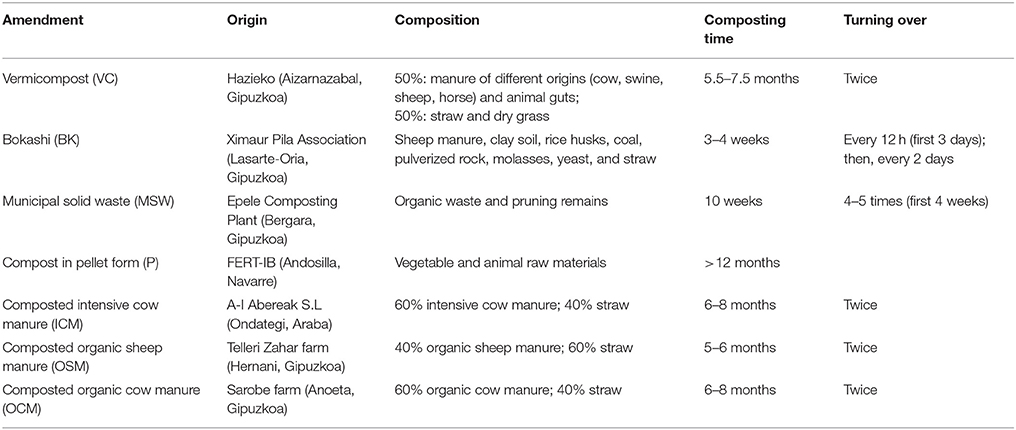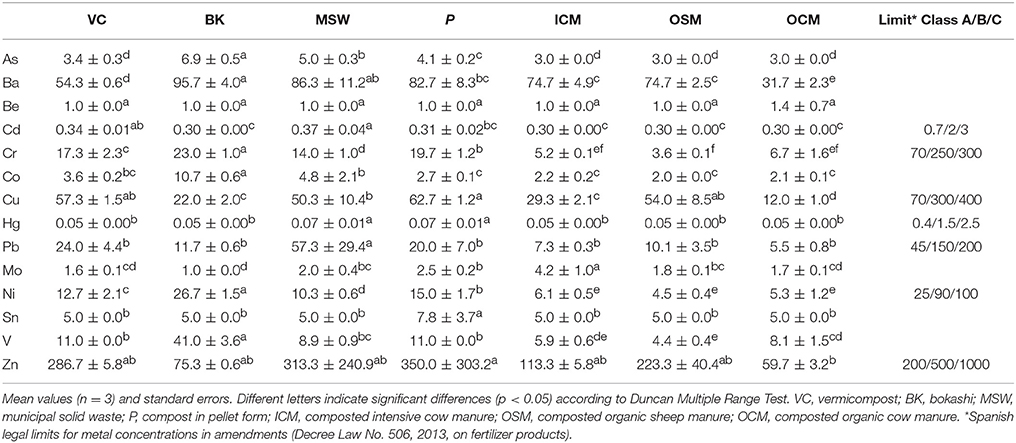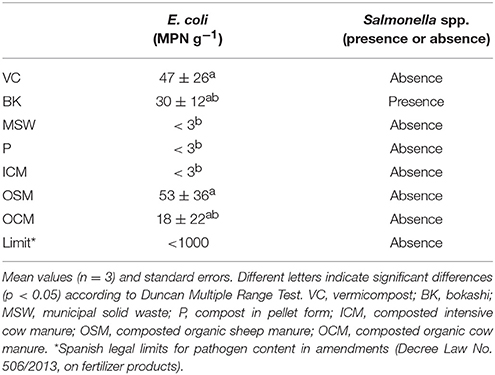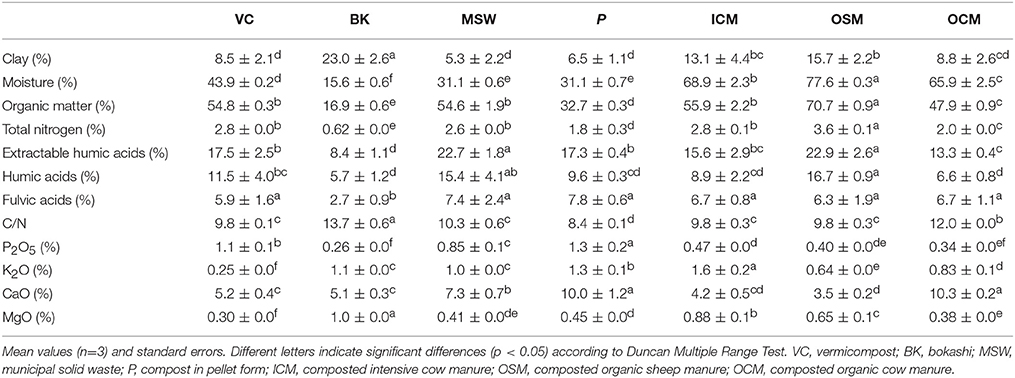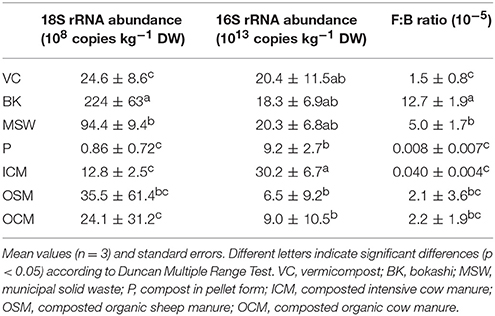- 1NEIKER, Basque Institute of Agricultural Research and Development, Derio, Spain
- 2Biolur Gipuzkoa, Bergara, Spain
- 3Karabeleko, Hernani, Spain
The application of organic amendments to agricultural soil provides organic matter and valuable nutrients, improves soil structure, increases its water holding capacity and stimulates soil microbial communities. However, when using organic amendments of animal and/or anthropogenic origin, the risk of contamination with organic and/or inorganic compounds, as well as the risk of dissemination of potential human pathogens and antibiotic resistance genes, must be taken into account. Here, we characterized seven amendments used in organic farming, in order to evaluate the agro-environmental consequences of their utilization. Amendments (vermicompost, bokashi, municipal solid waste, compost in pellet form, composted cow manure from intensive farms, composted cow manure from organic farms, composted sheep manure from organic farms) were sampled for the determination of (i) the presence of chemical (metals, aromatics, halogenated hydrocarbons, pesticides, phthalates, and total petroleum hydrocarbons) and biological (Escherichia coli, Salmonella, relative abundance of the integrase intl1 gene) contaminants; and (ii) their quality, in terms of physicochemical (moisture, organic matter, nutrients, C/N ratio) and microbial (potentially mineralizable nitrogen, microbial biomass carbon, bacterial and fungal abundance by real-time PCR, community-level physiological profiles through Biolog EcoPlates™) properties. Regarding metal concentrations, the only amendments that met the Spanish legal requirements for “Class A” fertilizers were composted intensive and organic cow manure. Zinc was the most limiting metal for the use of these amendments. None of the amendments showed high concentrations of organic contaminants. Bokashi was the only amendment in which Salmonella was detected. Besides, bokashi showed a high abundance of the integrase intl1 gene associated with class 1 integrons. Composted organic sheep manure showed the highest content of organic matter, total nitrogen, and extractable humic acids. Composted intensive cow manure showed highest values of microbial activity (potentially mineralizable N) and biomass (microbial biomass C, total bacteria). Owing to its low content of potentially health-threatening contaminants and its highest quality, as reflected by the Amendment Quality Index, composted intensive cow manure was concluded to be the most suitable amendment for agricultural use.
Introduction
Many agricultural soils have a low organic matter (OM) content and are thus more susceptible to erosion, desertification and climate change (Diacono and Montemurro, 2011). The application of organic amendments to agricultural soil can be a suitable option to reverse these negative effects. Besides, organic amendments can (i) improve soil structure and aggregation, (ii) enhance water holding capacity (Bulluck et al., 2002), (iii) increase soil OM and nutrient content (Park et al., 2011), (iv) control soil erosion and degradation (Ros et al., 2003), and (v) stimulate soil microbial activity and plant growth (Garcia et al., 1994; Pascual et al., 1997; Van-Camp et al., 2004).
The application of composted organic amendments has numerous advantages, compared to non-composted ones (Fernández et al., 2008). Besides, composting is considered a suitable waste management strategy, along with anaerobic digestion (Alvarenga et al., 2017). The production of organic wastes is increasing worldwide and then, nowadays, farmers have more access to composted amendments from different origins. Furthermore, the use of on-farm compost has increased in recent years, thus replacing commercial compost (Pane et al., 2015). Therefore, the use of organic compost represents both an appropriate waste management strategy and an interesting agricultural practice (Pérez-Piqueres et al., 2006), in compliance with the “end-of-waste” policy in Europe (Saveyn and Eder, 2014).
However, when using organic amendments of animal and/or anthropogenic origin, the risk of contamination with inorganic and/or organic compounds, as well as the risk of dissemination of potential human pathogens and antibiotic resistance genes, must be taken into account. In recent years, emerging contaminants (e.g., pesticides and their metabolites, pharmaceuticals, personal and house care products, food additives, industrial products and wastes, nanomaterials) have become a matter of much concern (Gomes et al., 2017). For example, the dissemination of antibiotic resistance genes, which can occur via the application of manure- and sewage sludge-derived amendments to agricultural soil (Martínez-Carballo et al., 2007; Udikovic-Kolic et al., 2014), is currently a matter of much concern due to the risk of transfer of antibiotic resistance genes to human pathogens (Marshall and Levy, 2011).
Physicochemical characteristics of the organic amendments are often determined in order to assess their suitability for agricultural use: organic carbon, total and organic nitrogen, C/N relationship, P2O5, K2O, humic substances, etc. (Decree Law No. 999, 2017). It is much less common to determine parameters related to the microbial activity, biomass and diversity of the organic amendments. Microbial activity is an essential factor for the successful operation of composting processes. It is then necessary to study microbial parameters in order to effectively control the composting process (Beffa et al., 1996), as well as to evaluate the final quality of the compost obtained.
Farmers, particularly those involved in organic agriculture, need appropriate organic amendments which, apart from meeting the current legal requirements, had been exhaustively characterized in terms of both benefits and risks. The selection of amendments for this study (Table 1) emerged from a deliberation process carried out by a local farmers' association, which identified locally abundant sources of organic amendments (urban or animal origin, commercial or not) suitable for their use in agriculture. In consequence, the aim of this study was to: (i) carry out an in depth-characterization of seven composted organic amendments, (ii) propose a methodology to select the most suitable amendments, and (iii) to deepen the knowledge of the potential benefits and risks associated with the application of composted organic amendments.
Materials and Methods
Amendments
Seven composted organic amendments, collected in the provinces of Araba, Gipuzkoa, and Navarre (northern Spain), were studied: vermicompost (VC), bokashi (BK), municipal solid waste (MSW), compost in pellet form (P), composted cow manure from intensive farms (ICM), composted cow manure from organic farms (OCM), and composted sheep manure from organic farms (OSM). The elaboration process of each amendment is described in Table 1. Three representative replicates of each amendment were sampled and stored at 4°C until analysis.
Presence of Contaminants
For the determination of the concentration of chemical contaminants in the studied amendments, the TerrAttesT® analytic package from Eurofins Scientific was used. This analytical package includes 185 contaminants (metals, aromatics, halogenated hydrocarbons, pesticides, phthalates, total petroleum hydrocarbons) determined by inductively coupled plasma atomic emission spectroscopy (ICP-AES), large volume injection-mass spectrometry (LVI-FC-MS) and gas chromatography with flame ionization detector (GC-FID).
Regarding biological contaminants, the presence (most probable number: MPN) of Escherichia coli was quantified following ISO 7251 (2005). The presence of Salmonella was determined following UNE-EN-ISO 6579 (2003).
DNA extraction was carried out from 0.25 g of amendment (three replicates per amendment) using PowerSoil™ DNA Isolation Kit (MO BIO Laboratories, Carlsbad CA), following the manufacturer's instructions. Prior to DNA extraction, samples were washed with 20 mM K2PO4 to remove extracellular DNA (Kowalchuk et al., 2002). DNA extracts were stored at −20°C. Real-time PCR was carried out to determine the relative abundance of the class 1 integron-integrase intl1 gene. The sequence-specific primers were intl1-F (GCCTTGATGTTACCCGAGAG) and intl1-R (GATCGGTCGAATGCGTGT), following Barraud et al. (2010). Each 25 μl reaction contained 2.5 μl of template, 12.5 μl of SYBR Premix Ex Taq (Takara), 2.5 μl of each primer at a concentration of 10 μM, 1.25 μl bovine serum albumin (40 mg ml−1), 0.5 μl of ROX dye and 3.25 μl of sterile Milli-Q water. Each sample was measured in triplicate. PCR conditions were as follows: 95°C for 15 s; 94°C for 30 s, 60°C for 30 s, 72°C for 1 min (40 cycles); and 95°C for 15 s, 60°C for 1 min, 95°C for 30 s for the melting curve, with a final extension of 60°C for 15 s. The relative abundance of intl1 gene was expressed in terms of relative abundance with respect to the structural 16S rRNA gene abundance (see below quantification of the 16S rRNA gene).
Amendment Quality
The following physicochemical parameters were measured in the studied amendments: organic matter (UNE-EN 130392, 2012), modified Kjeldahl nitrogen (UNE-EN 13654-1, 2002b), water soluble nutrients (P2O5, K2O, CaO, and MgO; UNE-EN 13652, 2002a), and humic substances (Decree Law No. 1110/1991, 1991).
Concerning microbial parameters, potentially mineralizable nitrogen (PMN), an indicator of microbial activity, was determined following Powers (1980). Microbial biomass carbon (MBC) was measured using the fumigation extraction method (Vance et al., 1987). Real-time PCR measurements were performed to determine the abundance of 16S rRNA (Ba519F/Ba907R primers) and 18S rRNA (Fung5F/FF390R primers) gene fragments for total bacteria and fungi, respectively (Lueders et al., 2004a,b). Reaction mixtures and PCR conditions are described in Epelde et al. (2014). Standards were made from plasmids containing the target sequence (Dhanasekaran et al., 2010).
Community-level physiological profiles (CLPPs) of cultivable heterotrophic bacteria were analyzed with Biolog EcoPlates™ (Insam, 1997) according to Epelde et al. (2008). Average well color development (AWCD) was calculated as the mean of every well's absorbance value at each reading time. The highest growth rate was observed at 48 h of incubation. At this time point, we calculated the Shannon's diversity index (H'), Simpson's diversity index (D), Shannon's evenness (E) and species richness (S). For these calculations, the number of utilized substrates (i.e., the number of substrates with an absorbance value >0.25) was used as proxy for species richness, and absorbance values at each well as equivalent to species abundance. The maximum slope and the area under the absorbance curve were measured following a trapezoidal approximation (Guckert et al., 1996).
Data Analysis
An Amendment Quality Index (AQI) was calculated from the values of OM, total N, P2O5, K2O, CaO, MgO, extractable humic acids, PMN, MBC, abundance of 16S and 18S rRNA genes, and area under the curve from Biolog EcoPlates™. For each parameter, the percentage of the maximum value found for that specific parameter in the whole set of samples was used for the calculation of the AQI:
where AQPi is the value of each parameter, Max AQPi is the maximum value for each parameter, and n is the number of parameters.
One-way analysis of variance (ANOVA) was conducted to look for statistical differences among the values of all the parameters measured here. Duncan Multiple Range Test post-hoc method was used for multiple comparisons at a 5% significance level. These analyses were conducted in R Core Team (v.3.4.0.).
The relationships between the quality parameters determined here in all the amendments were studied by means of a principal component analysis (PCA), using Canoco 5 (Ter Braak and Smilauer, 2012).
Results
Presence of Contaminants
In relation to metal concentrations (Table 2), bokashi showed significantly highest values of 6 out of the 14 metals measured here: arsenic (As), barium (Ba; together with MSW), chromium (Cr), cobalt (Co), nickel (Ni), and vanadium (V). The compost in pellet form, instead, had the highest values of copper (Cu; together with VC and OSM), mercury (Hg; together with P), tin (Sn), and zinc (Zn; together with all the other amendments, except for OCM). Municipal solid waste showed the highest concentration of cadmium (Cd; together with VC), mercury (Hg; together with P), and lead (Pb). Lastly, composted intensive cow manure showed the highest concentration of molybdenum (Mo). On the other hand, composted organic cow manure showed significantly lowest values of 12 out of the 14 metals measured here, while composted intensive cow manure and composted organic sheep manure showed the lowest concentrations of 9 out of the 14 metals.
According to Spanish Law No.506/2013, only two amendments, i.e., composted intensive cow manure and composted organic cow manure, met the requirements for “Class A” fertilizers. The rest of the amendments fitted in “Class B” fertilizers, due to the high concentrations of Zn (VC, MSW, P, OSM), Ni (BK), and Pb (MSW).
The concentrations of organic contaminants present in the amendments are shown in Supplementary Table 1. Bokashi showed significantly highest concentrations of some phenols. Regarding polycyclic aromatic hydrocarbons (PAHs), all amendments, apart from composted organic cow manure, showed highest values in one or another PAH fraction. Composted organic sheep manure showed the highest concentration of monochlorobenzene. In relation to chlorophenols, bokashi and municipal solid waste had the highest concentrations of 2,4,6-trichlorophenol and pentachlorophenol, respectively. Municipal solid waste also showed the highest concentration of some polychlorinated biphenyls. Regarding total petroleum hydrocarbons (TPHs), municipal solid waste, compost in pellet form and composted organic sheep manure showed highest values in two or three TPH fractions. Finally, bokashi and compost in pellet form showed the highest concentration of biphenyl and dibenzofuran, respectively.
In respect to the analyses performed here to quantify the presence of E. coli, the Spanish Decree Law No. 506, 2013 indicates that MPN values must be lower than 1,000 MPN g−1. Regarding the presence of Salmonella spp., it is compulsory (Decree Law No. 506/2013, 2013) not to detect its presence in 25 g of the sample. Highest values of MPN for E. coli were detected in composted organic sheep manure, followed by vermicompost, bokashi and composted organic cow manure (Table 3). The abundance of E. coli was below the quantification limit for municipal solid waste, compost in pellet form, and composted intensive cow manure. None of the amendments exceeded the legal requirement for E. coli. Instead, one of the replicates of bokashi was positive for Salmonella spp. (Table 3), exceeding the legal limit. The Salmonella serotype found in our bokashi amendment did not correspond to Enteritidis, Typhimurium, Hadar, Infantis, or Virchow (the serovars most often monitored in Europe).
Finally, the quantification of the class 1 integron-integrase intl1 gene abundance showed highest values in bokashi and compost in pellet form, followed by composted intensive cow manure and composted organic sheep manure (Figure 1). Vermicompost, municipal solid waste, and composted organic cow manure showed the lowest abundances of intl1 gene.
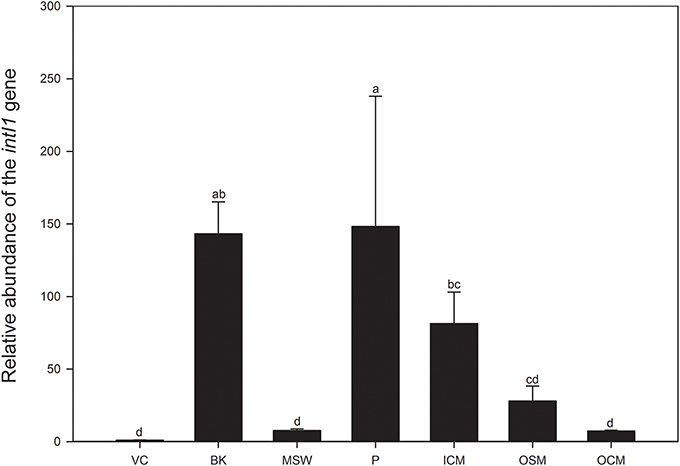
Figure 1. Relative abundance of the intl1 gene. Bars represent mean values (n = 3) and error bars represent standard errors. Bars labeled with different letters are significantly different (p < 0.05) according to Duncan Multiple Range Test. VC, vermicompost; BK, bokashi; MSW, municipal solid waste; P, compost in pellet form; ICM, composted intensive cow manure; OSM, composted organic sheep manure; OCM, composted organic cow manure.
Amendment Quality
Table 4 shows the results of the physicochemical properties measured here. Bokashi showed the highest clay percentage, and the compost in pellet form the lowest. Composted organic sheep manure showed the highest moisture content (an average of 77.6%), while bokashi had the lowest. All the amendments but bokashi, municipal solid waste and compost in pellet form surpassed the maximum limit (40% moisture) established by Spanish Decree Law No. 999, 2017.
Composted organic sheep manure had the highest content of OM (an average of 70.7%) and total N, while bokashi had the lowest. According to Spanish Decree Law No. 999, 2017, this type of amendments must have an OM content higher than 35% (30% for vermicomposts); thus, bokashi and compost in pellet form did not fulfill this requirement. Composted organic sheep manure, together with municipal solid waste, had the highest content of extractable humic acids. The highest C/N ratio was found in bokashi (13.7) and the lowest in compost in pellet form (8.4). In any case, all C/N values were below the maximum limit (C/N = 20) established by Decree Law No. 999, 2017. Finally, compost in pellet form showed the highest content of phosphorus and calcium (the latter together with composted organic cow manure), while composted intensive cow manure and bokashi had the highest content of potassium and magnesium, respectively.
Regarding microbial properties, composted intensive cow manure had significantly highest values of PMN (an average of 774 mg N-NH4 kg−1) (Figure 2) By contrast, the lowest PMN values were found in vermicompost, together with municipal solid waste, compost in pellet form, composted organic sheep manure and composted organic cow manure.
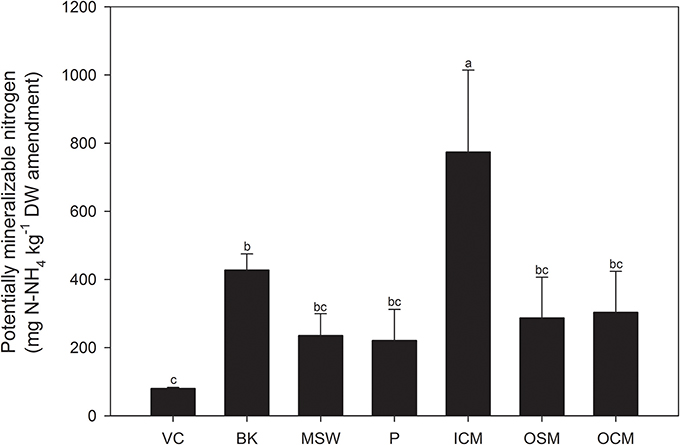
Figure 2. Potentially mineralizable nitrogen (PMN). Bars represent mean values (n = 3) and error bars represent standard errors. Bars labeled with different letters are significantly different (p < 0.05) according to Duncan Multiple Range Test. VC, vermicompost; BK, bokashi; MSW, municipal solid waste; P, compost in pellet form; ICM, composted intensive cow manure; OSM, composted organic sheep manure; OCM, composted organic cow manure.
In respect to microbial biomass, composted intensive cow manure showed the highest value of MBC (an average of 12,476 mg C kg−1) (Figure 3), followed by composted organic sheep and cow manure. Instead, vermicompost showed the lowest MBC value (<2,000 mg C kg−1), together with compost in pellet form. Bokashi showed the highest fungal gene abundance (Table 5). Composted intensive cow manure showed the highest bacterial gene abundance, together with vermicompost, bokashi and municipal solid waste. Finally, bokashi showed the highest F:B (fungi:bacteria) ratio.
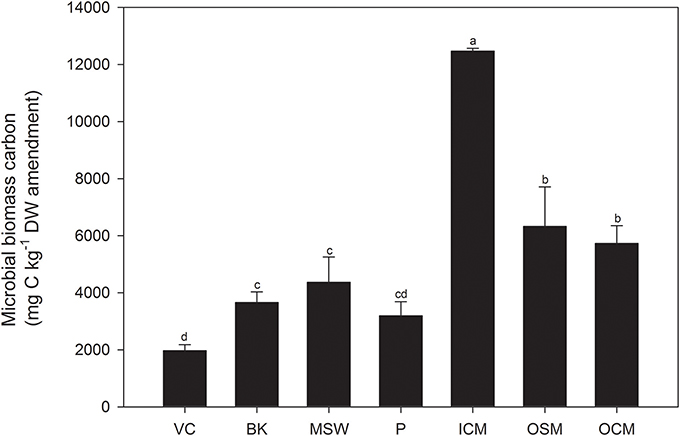
Figure 3. Microbial biomass carbon (MBC). Bars represent mean values (n = 3) and error bars represent standard errors. Bars labeled with different letters are significantly different (p < 0.05) according to Duncan Multiple Range Test. VC, vermicompost; BK, bokashi; MSW, municipal solid waste; P, compost in pellet form; ICM, composted intensive cow manure; OSM, composted organic sheep manure; OCM, composted organic cow manure.
Figure 4 shows the AWCD curves obtained with Biolog EcoPlates™. As reflected by the value of the area under the curve, vermicompost showed the highest overall microbial growth for the different C substrates (Table 6). Instead, composted organic sheep manure had the highest Shannon's diversity, Simpson's diversity and species richness, closely followed by vermicompost and composted organic cow manure. On the other hand, the lowest values obtained in these CLPPs (H′, D, S, maximum slope and area under the curve; the last two, together with composted intensive cow manure) corresponded to municipal solid waste and compost in pellet form.
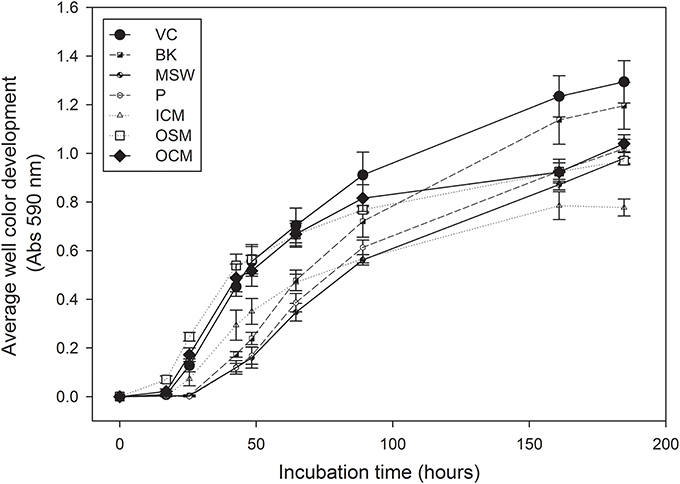
Figure 4. Average well color development (AWCD) curves from Biolog Ecoplates™. Simbols at different time points represent mean values (n = 3) and error bars represent standard errors. VC, vermicompost; BK, bokashi; MSW, municipal solid waste; P, compost in pellet form; ICM, composted intensive cow manure; OSM, composted organic sheep manure; OCM, composted organic cow manure.
The PCA performed from all the amendment quality parameters distributed the amendments in several groups (Figure 5). Composted organic sheep manure samples appeared associated with Biolog EcoPlates™ parameters (except for Shannon's evenness), while vermicompost appeared more related to the content of OM and total N toward the positive region of PC1 (which accounted for 31% of the variance). Along the positive region of PC2 (which accounted for 24% of the variance), bokashi samples showed high values of magnesium, C/N ratio and 18S rRNA gene abundance, and low values of fulvic acids. Instead, toward the negative region of PC2, municipal solid waste and compost in pellet form showed high contents of calcium.
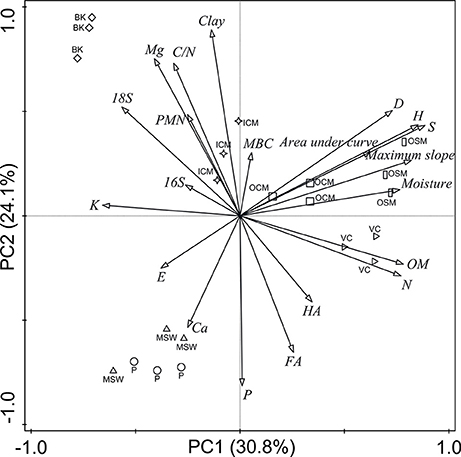
Figure 5. Principal component analysis obtained from all the amendment quality parameters. 16S, 16S rRNA gene copy abundance; 18S, 18S rRNA gene copy abundance; EHA, extractable humic acids; FA, fulvic acid; HA, humic acid; MBC, microbial biomass carbon; OM, organic matter; N, total nitrogen; PMN, potentially mineralizable nitrogen; H, Shannon's diversity; D, Simpson's diversity; E, Shannon's evenness; S, richness; VC, vermicompost; BK, bokashi; MSW, municipal solid waste; P, compost in pellet form; ICM, composted intensive cow manure; OSM, composted organic sheep manure; OCM, composted organic cow manure.
Finally, composted intensive cow manure showed significantly higher values of the AQI, compared to the other amendments (Figure 6).
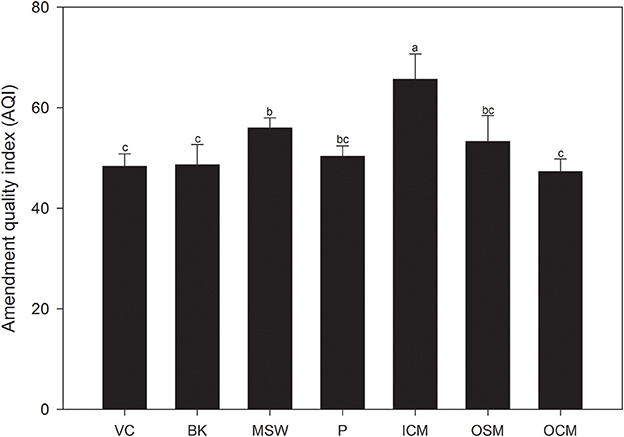
Figure 6. Amendment Quality Index (AQI). Bars represent mean values (n = 3) and error bars represent standard errors. Bars labeled with different letters are significantly different (p < 0.05) according to Duncan Multiple Range Test. VC, vermicompost; BK, bokashi; MSW, municipal solid waste; P, compost in pellet form; ICM, intensive cow manure; OSM, organic sheep manure; OCM, organic cow manure.
Discussion
Presence of Contaminants
The application of composted organic amendments to agricultural soil can enhance soil quality and fertility (Scotti et al., 2015). However, organic amendments represent a potential source of contaminants (e.g., heavy metals, organic compounds, human pathogens, mobile genetic elements, antibiotic resistance genes, etc.) and, hence, a potential risk for the environment and food security, since those contaminants can be distributed in the soil ecosystem and then become available for plant uptake (Smith, 2009).
Regarding metal concentrations, the only two amendments that met the Spanish legislation were composted intensive and organic cow manure. Zinc was the most limiting metal for the use of the studied amendments. Alvarenga et al. (2017) emphasized the risk of metal accumulation in soil and plants when organic amendments are regularly applied to agricultural land.
Compost quality standards differ considerably across European Member States (Cesaro et al., 2015). Unfortunately, there are no legal limits for organic and emerging (compounds previously unknown or undetected; the term includes a large variety of products such as pharmaceuticals, veterinary products, pesticides, nanomaterials, etc.) contaminants (Petrie et al., 2015). In this respect, highest abundance values for the intl1 gene, related to class 1 integrons, were found in compost in pellet form and bokashi. The presence of this mobile genetic element has been reported to be closely associated with the emergence and spread of antibiotic resistance genes in soil (Binh et al., 2008). The intl1 gene was proposed as a proxy for anthropogenic contamination, due to its relationship with antibiotic resistance genes, disinfectants and heavy metals (Gillings et al., 2015). According to Sun et al. (2016), anaerobic digestion generally reduces integron abundance, eliminating the aerobic hosts of such integrons.
Bokashi was the only amendment in which Salmonella was detected. The term bokashi refers to an anaerobic fermentation process that allows the generation of an amendment in just 2–3 weeks. Then, our bokashi amendment should be further hygienized by other means, in order to kill Salmonella strains.
Amendment Quality
Most of the amendments surpassed the maximum legal limit of 40% moisture content. This criterion is mainly intended to ease the spreading of the amendment. In any event, non-composted or immature compost amendments are known to present potential adverse effects on crops (e.g., inhibition of seed germination, weed problems, etc.; García et al., 1992).
The OM content of bokashi and compost in pellet form was too low for them to be considered organic amendments by the Spanish legislation. Instead, composted organic sheep manure showed the highest content of OM, total nitrogen and extractable humic acids. Extractable humic acids, which include humic and fulvic acids, improve soil fertility, permeability, aeration and aggregation when applied to soil (Salman et al., 2005). Extractable humic acids and C/N ratios are normally measured to determine the stability and maturity of composted amendments: in this respect, maturity is related with plant-growth potential and phytotoxicity, while stability is associated with the microbial activity of the amendment (Iannottil et al., 1993).
Microbial parameters which reflect the activity, biomass and diversity of microbial communities can provide useful information regarding (i) the properties of organic amendments, and (ii) the impact of contaminants and agricultural practices on soil quality (Epelde et al., 2010; Mijangos et al., 2010; Muñoz-Leoz et al., 2012; Pardo et al., 2014). Highest values of microbial activity (PMN) and biomass (MBC, 16S rRNA gene abundance) were found in composted intensive cow manure, suggesting that, when applied to agricultural soil, this amendment could stimulate soil microbial processes, such as, for instance, nutrient cycling. Ginting et al. (2003) reported that, 4 years after the last application, compost and manure application resulted in 20–40% higher soil MBC and 42–74% higher PMN, compared with the synthetic N fertilizer treatment.
Regarding the abundance of fungi and bacteria, bokashi showed the highest fungi-to-bacteria ratio. In general, fungi have longer lives than bacteria (Rousk and Bååth, 2007), and may be distinctive of mature and stable amendments. This seems to be contradictory with the faster elaboration time of bokashi, in comparison with the other amendments studied here. In any case, we could speculate that the anaerobic fermentation process carried out to obtain bokashi might have favored fungal communities, compared to the composting process used with the other amendments.
In relation with CLPPs, Biolog EcoPlates™ contain 31 carbon sources to measure the potential of the cultivable fraction of the heterotrophic bacterial community to metabolize them. Although vermicompost showed low values of microbial activity and biomass, it did show the highest values of area under the curve. This might be related to the presence of a more diverse bacterial community in vermicompost, capable of using a higher number of C sources, as a result of the higher variety of ingredients used during its production.
Finally, apart from the origin and nature of the ingredients, the composting process itself is a key determinant for the physicochemical and biological properties of the organic amendments. In fact, there is much interest in the temporal variability of the characteristics of the organic amendments during composting. In this respect, it is very important to perform analyses along the composting process in order to assess the maturity and stability of the amendment. In a recent study of the succession of bacterial community function during cow manure composting, Wang et al. (in Press) found that the AWCD of carboxylic acids and amino acids in Biolog EcoPlates™ displayed a steady downtrend along the composting process. In a similar way, a significant change in bacterial DGGE pattern was detected during garbage composting (Takaku et al., 2006). Gomez et al. (2006) found higher values of AWCD, richness and H′ diversity from Biolog EcoPlates™ in soil amended with household solid waste compost, horse, and rabbit manure, and chicken manure, compared to unamended soil. An in-depth study of the effects of the application of amendments on soil quality and crop performance is certainly essential to determine their suitability.
Concluding Remarks
Recommendations for the use of composted organic amendments must be based on the benefits and risks related to their characteristics. When assessing the suitability of this type of amendments for agricultural use, we propose that the first criterion must be the possibility of their containing potentially human health and environment-threatening contaminants. Both composted cow manures (from intensive and organic farms) were chosen according to this criterion. Secondly, the amendment with the highest value of the AQI should be considered. The AQI value could be further optimized by assigning numerical values to weigh the importance of each quality parameter and giving more value to key parameters such as macronutrient levels. Here, the highest AQI value corresponded to composted intensive cow manure. However, for organic agriculture, composted organic cow manure could be selected as the most suitable amendment.
Regulatory standards on the quality of organic amendments for agricultural use must be improved. At the moment, despite increasing awarenes of their well-known key role in nutrient cycling and mineralization, microbial properties are not considered, on a routine basis, when analysing amendment quality (except for some potential human pathogens, such as, for instance, E. coli and Salmonella spp.). Besides, only measurements of heavy metal concentrations are usually required, without paying attention to many organic and emergent contaminants, due to, among other reasons, cost restrictions. There is a strong demand for reliable and simple diagnostic markers (a minimum set of variables) that integrate the most relevant information regarding the benefits and risks associated with the use of organic amendments in agriculture. In this sense, the abundance of the intergrase intl1 gene appears a suitable biological diagnostic marker. Much efforts are still needed in this regard.
Author Contributions
LE, LI, JR, IG, and CG contributed to the conception and design of the study. LJ and JU carried out the laboratory analyses. All authors contributed to different aspects of data analysis and interpretation. LE and LJ wrote the paper. All remaining authors revised it critically.
Conflict of Interest Statement
The authors declare that the research was conducted in the absence of any commercial or financial relationships that could be construed as a potential conflict of interest.
Acknowledgments
This work has been financially supported by the Basque Government through Berriker Program (2015) and URAGAN project. LJ is the recipient of a predoctoral fellowship from the Department of Economic Development and Competitiveness of the Basque Government.
Supplementary Material
The Supplementary Material for this article can be found online at: https://www.frontiersin.org/articles/10.3389/fsufs.2018.00044/full#supplementary-material
References
Alvarenga, P., Palma, P., Mourinha, C., Farto, M., Dôres, J., Patanita, M., et al. (2017). Recycling organic wastes to agricultural land as a way to improve its quality: a field study to evaluate benefits and risks. Waste Manag. 61, 582–592. doi: 10.1016/j.wasman.2017.01.004
Barraud, O., Baclet, M. C., Denis, F., and Ploy, M. C. (2010). Quantitative multiplex real-time PCR for detecting class 1, 2 and 3 integrons. J. Antimicrob. Chemother. 65, 1642–1645. doi: 10.1093/jac/dkq167
Beffa, T., Blanc, M., Lyon, P. F., Vogt, G., Marchiani, M., Lott Fischer, J., et al. (1996). Isolation of Thermus strains from hot compost (60 to 80°C). Appl. Environ. Microbiol. 62, 1723–1727.
Binh, C. T. T., Heuer, H., Kaupenjohann, M., and Smalla, K. (2008). Piggery manure used for soil fertilization is a reservoir for transferable antibiotic resistance plasmids. FEMS Microbiol. Ecol. 66, 25–37. doi: 10.1111/j.1574-6941.2008.00526.x
Bulluck, L. R. III., Brosius, M., Evanylo, G. K., and Ristaino, J. B. (2002). Organic and synthetic fertility amendments influence soil microbial, physical and chemical properties on organic and conventional farms. Appl. Soil Ecol. 19, 147–160. doi: 10.1016/S0929-1393(01)00187-1
Cesaro, A., Berlgiorno, V., and Guida, M. (2015). Compost from organic solid waste: quality assessment and European regulations for its sustainable use. Res. Conserv. Recycl. 94, 72–79. doi: 10.1016/j.resconrec.2014.11.003
Decree Law No. 1110/1991 (1991). Official Methods of Analysis of Organic Fertilizer Products. Ministry of Relations with the Courts and the Ministry of the Government.
Dhanasekaran, S., Doherty, T. M., and Kenneth, J. (2010). Comparison of different standards for real-time PCR-based absolute quantification. J. Immunol. Methods 354, 34–39. doi: 10.1016/j.jim.2010.01.004
Diacono, M., and Montemurro, F. (2011). “Long-term effects of organic amendments on soil fertility,” in Sustainable Agriculture, Vol. 2, eds E. Lichtfouse, M. Hamelin, M. Navarrete, and P. Debaeke (Dordrecht: Springer), 761–786.
Epelde, L., Becerril, J. M., Hernández-Allica, J., Barrutia, O., and Garbisu, C. (2008). Functional diversity as indicator of the recovery of soil health derived from Thlaspi caerulescens growth and metal phytoextraction. Appl. Soil Ecol. 39, 299–310. doi: 10.1016/j.apsoil.2008.01.005
Epelde, L., Becerril, J. M., Kowalchuk, G. A., Deng, Y., Zhou, J., and Garbisu, C. (2010). Impact of metal pollution and Thlaspi caerulescens growth on soil microbial communities. Appl. Environ. Microbiol. 76, 7843–7853. doi: 10.1128/AEM.01045-10
Epelde, L., Burges, A., Mijangos, I., and Garbisu, C. (2014). Microbial properties and attributes of ecological relevance for soil quality monitoring during a chemical stabilization field study. Appl. Soil Ecol. 75, 1–12. doi: 10.1016/j.apsoil.2013.10.003
Fernández, J. M., Hockaday, W. C., Plaza, C., Polo, A., and Hatcher, P. G. (2008). Effects of long-term soil amendment with sewage sludges on soil humic acid thermal and molecular properties. Chemosphere 73, 1838–1844. doi: 10.1016/j.chemosphere.2008.08.001
Garcia, C., Hernández, T., Costa, F., and Ceccanti, B. (1994). Biochemical parameters in soils regenerated by the addition of organic wastes. Waste Manag. Res. 12, 457–466. doi: 10.1177/0734242X9401200602
García, C., Hernández, T., Costa, F., and Pascual, J. A. (1992). Phytotoxicity due to the agricultural use of urban wastes. Germination experiments. J. Sci. Food Agric. 59, 313–319. doi: 10.1002/jsfa.2740590307
Gillings, M. R., Gaze, W. H., Pruden, A., Smalla, K., Tiedje, J. M., and Zhu, Y. G. (2015). Using the class 1 integron-integrase gene as a proxy for anthropogenic pollution. ISME J. 9, 1269–1279. doi: 10.1038/ismej.2014.226
Ginting, D., Kessavalou, A., Eghball, B., and Doran, J. W. (2003). Greenhouse gas emissions and soil indicators four years after manure and compost applications. Environ. Qual. 32, 23–32. doi: 10.2134/jeq2003.2300
Gomes, A. R., Justino, C., Rocha-Santos, T., Freitas, A. C., Duarte, A. C., and Pereira, R. (2017). Review of the ecotoxicological effects of emerging contaminants to soil biota, J. Environ. Sci. Health A 52, 992–1007. doi: 10.1080/10934529.2017.1328946
Gomez, E., Ferreras, L., and Toresani, S. (2006). Soil bacterial functional diversity as influenced by organic amendment application. Bioresour. Technol. 97, 1484–1489. doi: 10.1016/j.biortech.2005.06.021
Guckert, J. B., Carr, G. J., Johnson, T. D., Hamm, B. G., Davidson, D. H., and Kumagai, Y. (1996). Community analysis by Biolog: curve integration for statistical analysis of activated sludge microbial habitats. J. Microbiol. Methods 27, 183–197. doi: 10.1016/S0167-7012(96)00948-7
Iannottil, D. A., Pang, T., Tothl, B. L., Elwell, D. L., Keener, H. M., and Hoitinkl, H. A. J. (1993). A quantitative respirometric method for monitoring compost stability. Compost Sci. Util. 1, 52–65. doi: 10.1080/1065657X.1993.10757890
Insam, H. (1997). “A new set of substrates proposed for community characterization in environmental samples,” in Microbial Communities. Functional Versus Structural Approaches, eds H. Insam, and A. Rangger (Heidelberg: Springer Verlag), 260–261.
ISO 7251 (2005). Microbiology of Food and Animal Feeding Stuffs – Horizontal Method for the Detection and Enumeration of Presumptive Escherichia coli – Most Probable Number Technique.
Kowalchuk, G. A., Buma, D. S., de Boer, W., Klinkhamer, P. G., and van Veen, J. A. (2002). Effects of above-ground plants species composition and diversity on the diversity of soil-borne microorganisms. Antonie Leeuwenhoek 81, 509–520. doi: 10.1023/A:1020565523615
Lueders, T., Manefield, M., and Friedrich, M. W. (2004a). Enhanced sensitivity of DNA- and rRNA-based stable isotope probing by fractionation and quantitative analysis of isopycnic centrifugation gradients. Environ. Microbiol. 6, 73–78. doi: 10.1046/j.1462-2920.2003.00536
Lueders, T., Wagner, B., Claus, P., and Friedrich, M. W. (2004b). Stable isotope probing of rRNA and DNA reveals a dynamic methylotroph community and trophic interactions with fungi and protozoa in oxic rice field soil. Environ. Microbiol. 6, 60–72. doi: 10.1046/j.1462-2920.2003.00535.x
Marshall, B. M., and Levy, S. B. (2011). Food animals and antimicrobials: impacts on human health. Clin. Microbiol. Rev. 24, 718–733. doi: 10.1128/CMR.00002-11
Martínez-Carballo, E., González-Barreiro, C., Scharf, S., and Gans, O. (2007). Environmental monitoring study of selected veterinary antibiotics in animal manure and soils in Austria. Environ. Pollut. 148, 570–579. doi: 10.1016/j.envpol.2006.11.035
Mijangos, I., Albizu, I., Epelde, L., Amezaga, I., Mendarte, S., and Garbisu, C. (2010). Effects of liming on soil properties and plant performance of temperate mountainous grasslands. J. Environ. Manage. 91, 2066–2074. doi: 10.1016/j.jenvman.2010.05.011
Muñoz-Leoz, B., Garbisu, C., Antigüedad, I., and Ruiz-Romera, E. (2012). Fertilization can modify the non-target effects of pesticides on soil microbial communities. Soil Biol. Biochem. 48, 125–134. doi: 10.1016/j.soilbio.2012.01.021
Pane, C., Celano, G., Piccolo, A., Villecco, D., Spaccini, R., Palese, A. M., et al. (2015). Effects of on-farm composted tomato residues on soil biological activity and yields in a tomato cropping system. Chem. Biol. Technol. Agric. 2, 4. doi: 10.1186/s40538-014-0026-9
Pardo, T., Clemente, R., Epelde, L., Garbisu, C., and Bernal, M. P. (2014). Evaluation of the phytostabilisation efficiency in a trace elements contaminated soil using soil health indicators. J. Hazard. Mater. 268, 68–76. doi: 10.1016/j.jhazmat.2014.01.003
Park, J. H., Lamb, D., Paneerselvam, P., Choppala, G., Bolan, N., and Chung, J. W. (2011). Role of organic amendments on enhanced bioremediation of heavy metal(loid) contaminated soils. J. Hazard. Mater. 185, 549–574. doi: 10.1016/j.jhazmat.2010.09.082
Pascual, J. A., García, C., Hernandez, T., and Ayuso, M. (1997). Changes in the microbial activity of an arid soil amended with urban organic wastes. Biol. Fertil. Soils 24, 429–434. doi: 10.1007/s003740050268
Pérez-Piqueres, A., Edel-Hermann, V., Alabouvette, C., and Steinberg, C. (2006). Response of soil microbial communities to compost amendments. Soil Biol. Biochem. 38, 460–470. doi: 10.1016/j.soilbio.2005.05.025
Petrie, B., Barden, R., and Kasprzyk-Hordern, B. (2015). A review on emerging contaminants in wastewaters and the environment: current knowledge, understudied areas and recommendations for future monitoring. Water Res. 72, 3–27. doi: 10.1016/j.watres.2014.08.053
Powers, R. F. (1980). Mineralizable soil nitrogen as an index of nitrogen availability to forest trees. Soil Sci. Soc. Am. J. 44, 1314–1320. doi: 10.2136/sssaj1980.03615995004400060037x
Ros, M., Hernandez, M. T., and García, C. (2003). Soil microbial activity after restoration of a semiarid soil by organic amendments. Soil Biol. Biochem. 35, 463–469. doi: 10.1016/S0038-0717(02)00298-5
Rousk, J., and Bååth, E. (2007). Fungal biomass production and turnover in soil estimated using the acetate-in-ergosterol technique. Soil Biol. Biochem. 39, 2173–2177. doi: 10.1016/j.soilbio.2007.03.023
Salman, S. R., Abou-Hussein, S. D., Abdel-Mawgoud, A. M. R., and El-Nemr, M. A. (2005). Fruit yield and quality of watermelon as affected by hybrids and humic acid application. Egypt J. Appl. Sci. 20, 244–259.
Saveyn, H., and Eder, P. (2014). End-of-Waste Criteria for Biodegradable Waste Subjected to Biological Treatment (Compost & Digestate): Technical Proposals. JR Scientific and Policy Reports (Seville: European Comission - Joint Research Centre).
Scotti, R., Bonanomi, G., Scelza, R., Zoina, A., and Rao, M. (2015). Organic amendments as sustainable tool to recovery fertility in intensive agricultural systems. J. Soil Sci. Plant Nutr. 15, 333–352. doi: 10.4067/S0718-95162015005000031
Smith, S. R. (2009). Organic contaminants in sewage sludge (biosolids) and their significance for agricultural recycling. Philos. Trans. A Math. Phys. Eng. Sci. 367, 4005–4041. doi: 10.1098/rsta.2009.0154
Sun, W., Qian, X., Gu, J., Wang, X. J., and Duan, M. L. (2016). Mechanism and effect of temperature on variations in antibiotic resistance genes during anaerobic digestion of dairy manure. Sci. Rep. 6:30237. doi: 10.1038/srep30237
Takaku, H., Kodaira, S., Kimoto, A., Nashimoto, M., and Takagi, M. (2006). Microbial communities in the garbage composting with rice hull as an amendment revealed by culture-dependent and independent approaches. J. Biosci. Bioeng. 101, 42–50. doi: 10.1263/jbb.101.42
Ter Braak, C. J. F., and Smilauer, P. (2012). Canoco Reference Manual and User's Guide: Software for Ordination, Version 5.0. Microcomputer Power. Ithaca, NY.
Udikovic-Kolic, N., Wichmann, F., Broderick, N. A., and Handelsman, J. (2014). Bloom of antibiotic-resistant bacteria in soil following manure fertilization. Proc. Natl. Acad. Sci. U.S.A. 111, 15202–15207. doi: 10.1073/pnas.1409836111
UNE-EN 13652 (2002a). Soil Improvers and Growing Media - Extraction of Water Soluble Nutrients and Elements.
UNE-EN 13654-1 (2002b). Soil Improvers And Growing Media - Determination of Nitrogen - Part 1: Modified Kjeldahl Method.
UNE-EN 130392 (2012). Soil Improvers and Growing Media - Determination of Organic Matter Content and Ash.
UNE-EN-ISO 6579 (2003). Microbiology of Food and Animal Feeding Stuffs - Horizontal Method for the Detection of Salmonella spp.
Van-Camp, G., Gentile, A. R., Bujarrabal, B., Jones, R., Montanarella, L., Claudia, O., et al. (2004). Reports of the Technical Working Groups Established under the Thematic Strategy for Soil Protection. Vol. III. Organic Matter. Luxembourg: Office for Official Publications of the European Communities.
Vance, E. D., Brookes, P. C., and Jenkinson, D. S. (1987). An extraction method for measuring soil microbial biomass C. Soil Biol. Biochem. 19, 703–707. doi: 10.1016/0038-0717(87)90052-6
Keywords: compost, contaminants, organic amendments, organic farming, waste management
Citation: Epelde L, Jauregi L, Urra J, Ibarretxe L, Romo J, Goikoetxea I and Garbisu C (2018) Characterization of Composted Organic Amendments for Agricultural Use. Front. Sustain. Food Syst. 2:44. doi: 10.3389/fsufs.2018.00044
Received: 22 May 2018; Accepted: 03 July 2018;
Published: 23 July 2018.
Edited by:
Paula Alvarenga, Instituto Superior de Agronomia (ISA), PortugalReviewed by:
Jaak Truu, University of Tartu, EstoniaLuís Miguel Brito, Polytechnic Institute of Viana do Castelo, Portugal
Copyright © 2018 Epelde, Jauregi, Urra, Ibarretxe, Romo, Goikoetxea and Garbisu. This is an open-access article distributed under the terms of the Creative Commons Attribution License (CC BY). The use, distribution or reproduction in other forums is permitted, provided the original author(s) and the copyright owner(s) are credited and that the original publication in this journal is cited, in accordance with accepted academic practice. No use, distribution or reproduction is permitted which does not comply with these terms.
*Correspondence: Lur Epelde, bGVwZWxkZUBuZWlrZXIuZXVz
 Lur Epelde
Lur Epelde Leire Jauregi
Leire Jauregi Julen Urra1
Julen Urra1 Carlos Garbisu
Carlos Garbisu